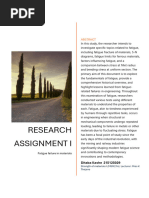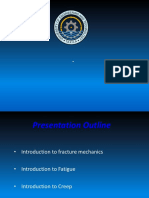Materials Science: Fatigue Analysis
Uploaded by
Ishwarya SrikanthMaterials Science: Fatigue Analysis
Uploaded by
Ishwarya SrikanthFATIGUE ANALYSIS
In materials science, fatigue is the weakening of a material caused by
repeatedly applied loads. It is the progressive and localised structural
damage that occurs when a material is subjected to cyclic loading.
The nominal maximum stress values that cause such damage may be
much less than the strength of the material typically quoted as
the ultimate tensile stress limit, or the yield stress limit.
Fatigue occurs when a material is subjected to repeated loading and
unloading. If the loads are above a certain threshold, microscopic
cracks will begin to form at the stress concentrators such as the
surface, persistent slip bands (PSBs), and grain interfaces.
Eventually a crack will reach a critical size, the crack will propagate
suddenly, and the structure will fracture. The shape of the structure
will significantly affect the fatigue life; square holes or sharp corners
will lead to elevated local stresses where fatigue cracks can initiate.
Round holes and smooth transitions or fillets will therefore increase the
fatigue strength of the structure.
Fatigue life
ASTM defines fatigue life, Nf, as the number of stress cycles of a specified
character that a specimen sustains before failure of a specified nature
occurs.
For some materials, notably steel and titanium, there is a theoretical
value for stress amplitude below which the material will not fail for any
number of cycles, called a fatigue limit, endurance limit, or fatigue
strength.
Engineers have used any of three methods to determine the fatigue
life of a material: the stress-life method, the strain-life method, and the
linear-elastic fracture mechanics method. One method to predict
fatigue life of materials is the Uniform Material Law (UML).
UML was developed for fatigue life prediction of aluminium and
titanium alloys by the end of 20th century and extended to highstrength steels, and cast iron.
Characteristics of fatigue
Fracture of an aluminium crank arm. Dark area of striations: slow crack
growth. Bright granular area: sudden fracture.
In metal alloys, when there are no macroscopic or microscopic
discontinuities, the process starts with dislocation movements, which
eventually form persistent slip bands that become the nucleus of short
cracks.
Macroscopic and microscopic discontinuities as well as component
design features which cause stress concentrations (holes, keyways, sharp
changes of direction etc.) are common locations at which the fatigue
process begins.
Fatigue is a process that has a degree of randomness (stochastic),
often showing considerable scatter even in well controlled environments.
Fatigue is usually associated with tensile stresses but fatigue cracks
have been reported due to compressive loads.[8]
The greater the applied stress range, the shorter the life.
Fatigue life scatter tends to increase for longer fatigue lives.
Damage is cumulative. Materials do not recover when rested.
Fatigue life is influenced by a variety of factors, such
as temperature, surface finish, metallurgical microstructure, presence
of oxidizing or inert chemicals, residual
stresses,
scuffing
contact
(fretting), etc.
Some materials (e.g., some steel and titanium alloys) exhibit a
theoretical fatigue limit below which continued loading does not lead to
fatigue failure.
High cycle fatigue strength (about 104 to 108 cycles) can be described
by stress-based parameters. A load-controlled servo-hydraulic test rig is
commonly used in these tests, with frequencies of around 2050 Hz.
Other sorts of machineslike resonant magnetic machinescan also be
used, to achieve frequencies up to 250 Hz.
Low cycle fatigue (loading that typically causes failure in less than
104 cycles) is associated with localized plastic behavior in metals; thus, a
strain-based parameter should be used for fatigue life prediction in
metals. Testing is conducted with constant strain amplitudes typically at
0.015 Hz.
You might also like
- Fundamentals of Metal Fatigue Analysis - J. A. Bannantine, J. J. Comer e J. L. Handrock, Editora Prentice Hall, 1990.100% (4)Fundamentals of Metal Fatigue Analysis - J. A. Bannantine, J. J. Comer e J. L. Handrock, Editora Prentice Hall, 1990.284 pages
- Fatigue Consideration in Design of Structures: By, Ambetkar Krunal D. (M. E. Structure-I)No ratings yetFatigue Consideration in Design of Structures: By, Ambetkar Krunal D. (M. E. Structure-I)24 pages
- We Are Intechopen, The World'S Leading Publisher of Open Access Books Built by Scientists, For ScientistsNo ratings yetWe Are Intechopen, The World'S Leading Publisher of Open Access Books Built by Scientists, For Scientists21 pages
- Presentation On A, Fatigue Life Estimation, Fatigue Crack Initiation Mechanism, Avoidance of Fatigue DamageNo ratings yetPresentation On A, Fatigue Life Estimation, Fatigue Crack Initiation Mechanism, Avoidance of Fatigue Damage24 pages
- Introduction To Materials Science:: Indian Institute of Technology RoorkeeNo ratings yetIntroduction To Materials Science:: Indian Institute of Technology Roorkee15 pages
- Theory and Design of Mechanical SystemsNo ratings yetTheory and Design of Mechanical Systems40 pages
- High Cycle Fatigue Analysis Stress Life Made Easy White PaperNo ratings yetHigh Cycle Fatigue Analysis Stress Life Made Easy White Paper17 pages
- Machine Elements I Chapter VI (08.08.2020)No ratings yetMachine Elements I Chapter VI (08.08.2020)123 pages
- 2022 - Stinvilleet Al., On The Origin of Fatigue Strength in Crystalline Metallic MaterialsNo ratings yet2022 - Stinvilleet Al., On The Origin of Fatigue Strength in Crystalline Metallic Materials7 pages
- Fatigue ?: Furthermore, Fatigue Is Catastrophic and Insidious, Occurring Very Suddenly and Without WarningNo ratings yetFatigue ?: Furthermore, Fatigue Is Catastrophic and Insidious, Occurring Very Suddenly and Without Warning46 pages
- ASM Metal and Plastic Fatigue-Information-MaterialNo ratings yetASM Metal and Plastic Fatigue-Information-Material11 pages
- Engineering Failure Analysis: Colin R Gagg, Peter R LewisNo ratings yetEngineering Failure Analysis: Colin R Gagg, Peter R Lewis19 pages
- Background on Fatigue and Its SignificanceNo ratings yetBackground on Fatigue and Its Significance5 pages
- Intro To Fracture Mechanics, Fatigue and Creep100% (1)Intro To Fracture Mechanics, Fatigue and Creep40 pages
- Fatigue: Bryan Mangampo Nicole Olavario Chaby Ros100% (1)Fatigue: Bryan Mangampo Nicole Olavario Chaby Ros12 pages


































































